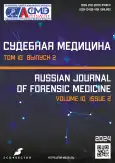乙醇中毒死亡者面部的一些变化
- 作者: Plis S.S.1, Veselkina O.V.1,2, Maksimov A.V.2,3
-
隶属关系:
- Institute of Forensic Medicine and Pathology
- Moscow Regional Research and Clinical Institute
- Federal State University of Education
- 期: 卷 10, 编号 2 (2024)
- 页面: 171-180
- 栏目: 原创研究
- URL: https://journals.rcsi.science/2411-8729/article/view/262742
- DOI: https://doi.org/10.17816/fm16109
- ID: 262742
如何引用文章
全文:
详细
论证。面部变化(面部肿胀,颜色发紫或发青;流涎;流泪;A.P. Kurdyumov 描述的体征)是乙醇中毒时经常观察到的体征之一。然而,这些症状的诊断能力尚未得到研究,其发生机制也未得到描述。
研究目的是调查死者面部因乙醇中毒而发生的变化,并从现代角度评估这些变化的发生机制、特征和特异性。
材料和方法。本研究以法医检验局的档案为基础,开展了一项单中心回顾性横断面观察研究。该研究包括 2020 年 1 月 1 日至 2020 年 12 月 31 日期间的死亡病例(n=1181,中位年龄 52岁)。这些病例被分为五组:乙醇中毒、其他酒精中毒、窒息、其他暴力致死原因、自然死亡。
结果。女性年龄较大,血液中乙醇浓度无明显差异。53.1% 的乙醇中毒病例出现面部浮肿,59.5% 的病例出现面部青紫。A.P. Kurdyumov 所描述的症状出现频率最低。面部浮 肿(p=0.002)和 A.P. Kurdyumov 所描述的体征(p=0.014)在其他酒精中毒中比在窒息死亡中更常被观察到,而面部青紫(p=0.176)则没有类似的差异。面部青紫在酒精中 毒(59.53%)和其他酒精中毒(40.74%)中的敏感性最高,但在同类体征中特异性最低。在乙醇中毒和其他酒精中毒中,A.P. Kurdyumov 所描述的体征的特异性最高。
结论。面部青紫是乙醇中毒中最敏感的体征,A.P. Kurdyumov 体征是所分析的体征中最特异的。在乙醇中毒和其他酒精中毒中都观察到了所研究的体征,但频率较低。所研究的法医征象在许多方面与临床医生观察到的潮汐综合征征象相似。
作者简介
Semyon S. Plis
Institute of Forensic Medicine and Pathology
编辑信件的主要联系方式.
Email: SSPlis.work@gmail.com
ORCID iD: 0000-0002-0232-0425
SPIN 代码: 4347-1925
MD
俄罗斯联邦, MoscowOlesya V. Veselkina
Institute of Forensic Medicine and Pathology; Moscow Regional Research and Clinical Institute
Email: ves-olesya@yandex.ru
ORCID iD: 0000-0002-9486-5421
SPIN 代码: 9188-2988
MD
俄罗斯联邦, Moscow; MoscowAleksandr V. Maksimov
Moscow Regional Research and Clinical Institute; Federal State University of Education
Email: mcsim2002@mail.ru
ORCID iD: 0000-0003-1936-4448
SPIN 代码: 3134-8457
MD, Dr. Sci. (Med.), Assistant Professor
俄罗斯联邦, Moscow; Moscow参考
- Gromov S. Summary of forensic medicine for academic and practical use (second edition, corrected and supplemented). Saint Petersburg: Tipography of Eduard Prats and K; 1838. 576 р. (In Russ).
- Dyberg. On the decision of the question: Whether death was a consequence of injury or immoderate consumption of alcoholic beverages. Arch Forensic Med Public Hygiene. 1866;(2):34–52. (In Russ).
- Sushchinsky PG. Death from intoxication (acute alcohol poisoning) in forensic medicine [dissertation]. Moscow: Imperial Moscow University; 1867. (In Russ).
- Strauch. On alcohol poisoning. Military Medical J Published Med Department Military Ministry. 1853;(LXI):1–16. (In Russ).
- Blosfeld GA. About drunkenness in forensic-medical and medical-police relations (end). Notes on the part of medical sciences, published at the Imperial Saint Petersburg Medical and Surgical Academy. 1846. Book 2. P. 94–130. (In Russ).
- Briand J. A complete guide to forensic medicine: [work] by Professor Briand, with the addition of a guide to forensic chemistry, compiled by Gautier de Clobry, Professor of the General Pharmaceutical School. Transl. from the 6th (French) edition. Saint Petersburg: Tipography of the Library of Medical Sciences of Dr M. Khan; 1860. 11 р. (In Russ).
- Kurdyumov AP. About one sign of acute poisoning by alcohol and its surrogates. Forensic Med Border Areas. 1934;(1):59–63. (In Russ).
- Eng MY, Luczak SE, Wall TL. ALDH2, ADH1B, and ADH1C genotypes in Asians: A literature review. Alcohol Res Health. 2007;30(1):22–27.
- Mizoi Y, Ijiri I, Tatsuno Y, et al. Relationship between facial flushing and blood acetaldehyde levels after alcohol intake. Pharmacol Biochem Behav. 1979;10(2):303–311. doi: 10.1016/0091-3057(79)90105-9
- Chen YC, Lu RB, Peng GS, et al. Alcohol metabolism and cardiovascular response in an alcoholic patient homozygous for the ALDH2*2 variant gene allele. Alcohol Clin Exp Res. 1999;23(12):1853–1860.
- Whitfield JB, Martin NG. Alcohol reactions in subjects of European descent: Effects on alcohol use and on physical and psychomotor responses-alcohol. Alcohol Clin Exp Res. 1996;20(1):81–86. doi: 10.1111/j.1530-0277.1996.tb01048.x
- Moiseev VS, Shalepin AA. Alcohol and heart disease. Moscow: GEOTAR-Media; 2009. 168 р. (In Russ).
- Oota H, Pakstis AJ, Bonne-Tamir B, et al. The evolution and population genetics of the ALDH2 locus: Random genetic drift, selection, and low levels of recombination. Ann Hum Genet. 2004;68(2):93–109. doi: 10.1046/j.1529-8817.2003.00060.x
- Solopyokin NV. An estimate of polymorphism of Adh1b, Aldh2, and Cyp2e1 alcohol biotransformation genes in Siberian indigenous and immigrant populations. Bulletin Moscow University. Biology. 2015;(2):32–34. EDN: MOAIWC
- Allali-Hassani A, MartÍnez SE, Peralba JM, et al. Alcohol dehydrogenase of human and rat blood vessels: Role in ethanol metabolism. FEBS Lett. 1997;405(1):26–30. doi: 10.1016/s0014-5793(97)00151-8
- Ijiri I. [Biological actions of acetaldehyde. (In Japanese)]. Nihon Hoigaku Zasshi. 1999;53(3):285–295.
- Klevno VA, Maksimov AV, Kuchuk SA, et al. Methodical recommendations on forensic medical examination of alcohol poisoning. Russ J Forensic Med. 2020;6(1):51–59. EDN: KUDYWL doi: 10.19048/2411-8729-2020-6-1-51-59
- Plis SS, Kovalenko LA, Veselkina OV, et al. Alcohol and children: Clinical and forensic study. Russ J Forensic Med. 2022;8(2):13–22. EDN: LCHGOH doi: 10.17816/fm709
- Serebryanikov PW, Shuster I. About quantitative determination of alcohol in a corpse by the method of Prof. Nicloux. Trudy Krymskogo gosudarstvennogo meditsinskogo instituta imeni Stalina Psikhologicheskii zhurnal. 1937;(4):3–8. (In Russ).
补充文件









